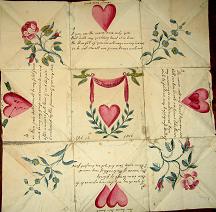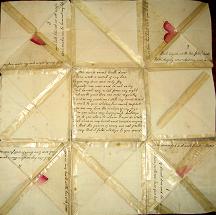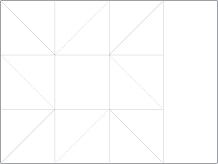|
Puzzle purses are origami-like folded paper that have been used around the world, and here we are concerned with puzzle purses used as valentines and also baptismal certificates which were folded in the same way.
In the olden days, valentine puzzle purses would often have the squares numbered, to be read in order as each leaf is opened, with a final message or picture in the center.
A puzzle purse is easy to recognize as it will have visible creases used to fold it. Very often they were folded into thirds in both horizontal and vertical directions, with the resulting square then folded along its diagonals. This results in the paper being divided into 9 equally sized squares, each of which has an "X" mark, due it having been folded along both diagonals.
I have in my collection a 300-year-old Baptismal Certificate with X folds in all 9 squares, and it is folded in the same way as my valentine puzzle purses.
I have folded some photographs of my puzzle purses in an attempt to recreate the original object which are too delicate to be handled, and I have noted that the traditional folding method creates many creases unneeded by the puzzle purse.
Without the extraneous creases, the purse will open and fold much more easily, so I have devised a method without making unnecessary creases, which I present below (see separate color diagram with brief explanation).
I use a bone knife to create each crease as in the diagram, and then turn the paper over to continue on the reverse side as needed. Each crease is only bent in the necessary direction. Once all creases have been initiated with the knife, complete all of the folds (the horizontal, vertical and diagonal lines) only as drawn. Once you remember the pattern you will be able to do it with only a few pencil marks used to divide the paper into thirds. A light gray colored template you can print out is also provided.
This technique has proven to be more accurate, since you do not have to fold several layers of paper at once, and is better for thicker paper while also being easier to fold into a purse after all creases have been made.
For those of you who wish to fold the traditional way however, in which every square gains an X of two creases, read on.
Folding Nancy's Puzzle Purse the Traditional Way
Obtain a square piece of paper, or create one by folding one corner to the opposite side and trimming the remaining strip to form a square.
Here we talk about valley folds and mountain folds. A valley fold is when you fold two edges of paper up so they create a creased depression like a valley, and a mountain fold will be the opposite in which you bend either side of the paper away from you to make a projection toward your face.
Create two valley folds (you can look deep down into the valley produced) by first folding one corner to its diagonally opposite corner and creasing, then opening it and folding the other corner. You end up with an X across your paper now opened.
Now divide the paper into 9 equal squares. An easy way is to draw two lines on the paper parallel to one of the sides, then use a ruler to measure out two points on each and connect the points. This will create two of the four lines you need to make your "tic tac toe" diagram. Note the points where your lines intersect the X diagonal creases and draw the other two lines you need through them, now you should have the paper divided into 9 equal squares (drawing in pencil).
Make two valley folds on the two vertical lines so the right and left sides of the paper come toward each other. Press down so you now have a tall thin piece of triple ply paper. Next fold the top and bottom towards each other also, so you have now 1/9 of the original size of the paper.
Fold corners diagonally toward each other twice to make an X crease.
Now open. You should have an X crease in each of the 9 squares, and the four creases outlining the center square should all be valley folds. This center square will be the bottom of the puzzle purse.
The folds have all been made, now all that remains is to snap it into shape!
If north is straight ahead and away from you, then take the northeast corner in your right hand and the southwest corner in your left hand. All corners should have a valley fold going from the very corner point toward the center square. Fold this valley fold closed for the "ear" (the corner square) you are holding in each of your hands.
Now understand the puzzle purse is actually based around the idea of a pinwheel or twist purse. Bring your two hands towards the center while bringing your right hand toward you and your left hand away from you, in other words spinning clockwise around the center axis of the purse. It will only close in one direction. The tension should cause the purse (all four corners) to close in toward the center, and if you push down when all four corner squares come together you will get a pinwheel.
Four points of the pinwheel will be sticking out. Each little triangle that sticks out should be folded in toward the center (do so in clockwise order). Finally, tuck the last triangle into the pocket provided in the back the first one tucked in. You will now have a closed puzzle purse.
Happy folding!
Nancy Rosin
|


